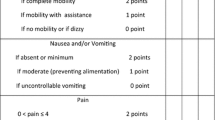Abstract
Background
The preincisional use of ketamine combined with local tissue infiltration with Ropivacaine may reduce noxious input during surgery. The goal of this study was to examine whether this combination improves postoperative pain control after laparoscopic cholecystectomy.
Methods
A total of 55 patients were randomly assigned to one of three groups. Group 1 received placebos preincisional. Group 2 received preincisional saline IV and local infiltration with 20 ml ropivacaine (10 mg/ml). Group 3 received preincisional ketamine 1 mg/kg IV and local infiltration with 20 ml ropivacaine (10 mg/ml). Postoperative pain was rated at 0, 3, 6, 12, 24, and 48 h postoperatively by visual analogue scale scores (VAS). Cumulative analgesic consumption and time until first analgesic medication request were recorded.
Results
Group 3 experienced significantly (p<0.05) less pain than group 2 at 6 h and 12 h postoperatively. Groups 2 and 3 did not differ significantly by VAS at 0 h, 3 h, 24 h, and 48 h. Group 1 had significantly higher VAS scores than groups 2 and 3 at 0 h, 3 h, 6 h, 12 h, and 24 h postoperatively. The consumption of analgesics was significantly higher in group 1 than in groups 2 and 3. Although the consumption of analgesics was higher in group 3 than in group 2, this difference did not reach statistical significance. The time to first request for analgesics was significantly longer in groups 2 and 3 than in group 1, with no statistical difference between groups 2 and 3.
Conclusion
Preincisional treatment with low-dose IV ketamine and local infiltration with ropivacaine 1% reduces postoperative pain after laparoscopic cholecystectomy.
Similar content being viewed by others
References
Aida S, Yamakura T, Baba H, Taga K, Fukuda S, Shimoji K (2000) Preemptive analgesia by intravenous low-dose ketamine and epidural morphine in gastrectomy: a randomized double-blind study. Anesthesiology 92: 1624–1630
Arendt-Nielsen L, Petersen-Felix S (1995) Wind-up and neuroplasticity: is there a correlation to clinical pain? Eur J Anaesth 12 (Suppl 10): 1–7
Arendt-Nielsen L, Petersen-Felix S, Fisher M, Bak P, Bjerring P, Zbinden AM (1995) The effect of N-methyl-D-aspartate antagonist (ketamine) on single and repeated nociceptive stimuli: a placebo-controlled experimental human study. Anesth Analg 81: 63–68
Bisgaard T, Klarskov B, Kristiansen VB, Callesen T, Schulze S, Kehlet H, Rosenberg J (1999) Multi-regional local anesthetic infiltration during laparoscopic cholecystectomy in patients receiving prophylactic multi-modal analgesia: a randomized, double-blinded, placebo-controlled study. Anesth Analg 89: 1017–1024
Bon K, Lanteri-Minet M, de Pommery J, Michiels JF, Menetrey D (1996) Cyclophosphamide cystitis as a model of visceral pain in rats: a survey of hindbrain structures involved in visceroception and nociception using the expression of c-fos and Krox-24 proteins. Exp Brain Res 108: 404–416
Bonica JJ (1990) General considerations of abdominal pain. In: Bonica JJ (ed) The management of pain. 2nd ed. Philadelphia. Lea & Febiger, pp 1146–1231
Dahl V, Ernoe PE, Steen T, Raeder JC, White PF (2000) Does ketamine have preemptive effects in women undergoing abdominal hysterectomy procedures? Anesth Analg 90: 1419–1422
Ilkjaer S, Nikolajsen L, Hansen TM, Wernberg M, Brennum J, Dahl JB (1998) Effect of i.v ketamine in combination with epidural morphine on postoperative pain and wound tenderness after renal surgery. Br J Anaesth 81: 707–712
Mathisen LC, Aasbo V, Raeder J (1999) Lack of pre-emptive analgesic effect of (R)-Ketamin in laparoscopic cholecystectomy. Acta Anaesthesiol Scand 43: 220–224
Oye I (1998) Ketamine analgesia, NMDA receptors and the gates of perception. Acta Anaesthesiol Scand 42: 747–749
Pedraz JL, Lanao JM, Calvo MB (1987) Pharmacokinetic and clinical evaluation of ketamine administered by i.v. and epidural routes. Int J Clin Pharmacol Ther Tox 25: 77–80
Royblat L, Korotkoruchko A, Katz J, Glazer M, Greemberg L, Fisher A (1993) Postoperative pain: the effect of low-dose ketamine in addition to general anesthesia. Anesth Analg 77: 1161–1165
Schuligoi R, Josic M, Heinemann A, Schoninkle E, Pabst MA, Holzer P (1998) Gastric acid-evoked c-fos messenger RNA expression in rat brainstem is signaled by capsaicin-resistant vagal afferents. Gastroenterology 115: 649–660
Segawa H, Mori K, Kasai K, Fukuda J, Nakao K (1996) The role of the phrenic nerves in stress response in upper abdominal surgery. Anesth Analg 82: 1215–1224
Sukiennik AW, Kream RM (1995) N-methyl-D-aspartate receptors and pain. Curr Op Anesth 8: 445–449
Woolf C, Chong MS (1993) Preemptive analgesia: treating postoperative pain by preventing the establishment of central sensitization. Anesth Analg 77: 362–379
Author information
Authors and Affiliations
Additional information
Online publication: 12 June 2001
Rights and permissions
About this article
Cite this article
Papaziogas, B., Argiriadou, H., Papagiannopoulou, P. et al. Preincisional intravenous low-dose ketamine and local infiltration with ropivacaine reduces postoperative pain after laparoscopic cholecystectomy. Surg Endosc 15, 1030–1033 (2001). https://doi.org/10.1007/s004640090124
Received:
Accepted:
Issue Date:
DOI: https://doi.org/10.1007/s004640090124




